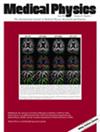Quantifying the dosimetric accuracy of expiration-gated stereotactic lung radiotherapy
Abstract
Background
In stereotactic body radiotherapy, a form of motion management is often applied to mobile lung tumors. Gated radiotherapy is such form of motion management in which the radiation beam is switched on or off depending on the actual tumor position. Compared to inspiration, the tumor position is typically more stable during expiration. Also, the tumor spends more time in expiration position. Therefore, we often consider expiration-gating for patients with relatively large tumor motion.
Purpose
We validated dosimetric accuracy of expiration-gated stereotactic lung radiotherapy by means of phantom measurements and modeling the effects of residual motion in patients.
Methods
Dose profiles from film measurements in a respiratory-motion phantom were compared to dose calculations, for different expiration gating methods. Fluoroscopic real-time tumor tracking was used to produce a convolution kernel which was applied to the calculated dose distribution to model dosimetric effects of residual motion. This convolution method was validated against film measurements and then retrospectively applied to clinical tumor tracking data of five patients. In addition, clinical tumor motion data was manipulated to simulate the effect of a short breathing period of 2 s and prolonged gating latency of 500 ms.
Results
A good agreement between calculated and measured dose was found when amplitude gating was used (100% gamma pass rate, 3%/2 mm). For phase gating, good agreement required a stable breathing period. Measurements showed good performance of the convolution method (gamma pass rate > 99%). For the clinical data, we found a maximal dose shift of 2.4 mm, introduced by residual tumor motion or respiratory drift. For all patients, the size of the ITV was adequate to account for this dose shift. Simulating higher breathing speed in combination with large latency values resulted in dosimetric shifts that were larger than the PTV margin.
Conclusion
Amplitude gating is robust for irregular breathing patterns. Expiration-gating is a dosimetrically accurate method of treatment delivery provided that during delivery there is a prompt reaction to respiratory drift and the latency of the gating system is short.


 求助内容:
求助内容: 应助结果提醒方式:
应助结果提醒方式:


